Sometimes you only have to tell a guy once that behaving a certain way could have consequences. But when the warning signs outnumber logic, you can’t blame a fellow for being a bit skeptical. In the case of tropical northern Queensland, put your skepticism aside -- everything here wants to kill you. In fact, plane tickets to Cairns should come with a warning label, much like a pack of cigarettes, or rat poison, or hydrochloric acid or ... you get the idea.
For instance, the short walk from the hotel in Port Douglas in the tropical north of Queensland to the beach was a jaunt ripe with caution.
First, I was told by the concierge not to touch the tar tree along the trail through the jungle to the water. Nasty burns, he told me--enough to ruin a weekend.
“Got it. Don’t touch the tar tree.” Upon arrival, a handy sign and a mesh fence ensured that I wouldn’t forget this advice. I did not touch the tar tree.
On my way out the door, the bellman gave me some sage advice.
“Listen, mate,” he said. “I was down there day before last, and a taipan wiggled across the trail in front of my feet. Whatever you do, don’t mess with a taipan.”
Check. Taipan. Leave it be. Wait. What’s a taipan?
“It’s a snake, mate. A bad one, at that. A real killer.”
Indeed, the coastal taipan is the fourth-most venomous snake on earth -- a single bite will kill a human inside an hour if antidote isn’t administered, and even if it is, the hospital stay is a long one. The venom in a single taipan -- a flat, brown, rather unremarkable looking snake -- is enough to take out 12,000 Guinea pigs. Yes. You read that correctly. 12,000 Guinea pigs.
So needless to say, I spent my days in the tropical north watching every step for fear of irking a taipan.
When I finally got to the beach -- tar and snake-bite free -- I was immediately greeted by a big yellow caution sign. It simply read: “Marine stingers are present in these waters during summer months.” It depicted a swimmer being attacked by a massive box jellyfish, whose sting can, indeed, prove fatal.
I’d walked just a couple hundred yards and been warned three times of the threats that could, with a little carelessness on my part, end my life. Thankfully, it was August -- nearing the end of winter -- and no “marine stingers” were lingering in the warm, tropical waters of the Coral Sea. But the water contained other unseen threats. Where the rain-swollen Mossman River enters the sea, I was told, massive saltwater crocodiles lie in wait for anything edible -- dogs, cats … fly fishermen.
“Just stand a bit away from the edge, mate,” the clerk at Bransford’s tackle shop in Cairns told me. “You’ll probably be all right.”
So as I wandered down the beach on that steamy late-winter day in search of barramundi enroute to the Mossman estuary, the word “probably” kept dancing around in my head.
Yeah. I psyched myself out. I hooked one nice barracuda but I didn’t want to step too close to the water to retrieve it, and the 20-pound leader snapped. Long-distance release -- I happily donated my Clouser to the murky Mossman. There’s something terrifying about the prospect of a 15-foot croc springing from the muddy water with nothing but a death roll on its mind.
Barramundi? I’ll wait until I can afford a boat. And a bazooka.
“So,” I asked the clerk, “where do I go to catch a jungle perch?”
Now, realize one thing. The barramundi is the undisputed king of the tropical north when it comes to fly fishing. There are other worthy targets, though, like giant trevally, queenfish and even snappers and mackerel. But the barramundi of the tropical rivers and estuaries is the Australian Valhalla when it comes to inshore and inland fly fishing.
The jungle perch? Well… they sure are cute. And they live in crystal-clear rainforest streams, well away from saltwater crocs, marine stingers and tar trees.
“Just follow the Mulgrave River above Goldsborough,” the told me. “Lots of ‘junglies’ up there.” He handed me a few bright green freshwater shrimp patterns and sent me on my way with a smile.
So I did as suggested. I followed the Mulgrave River Road out of Cairns and the first thing I noticed on the highway was yet another warning sign.
“Don’t transport electric ants!”
Seriously? Electric ants? Turns out these tiny little critters -- they’re about 1.5 millimeters long -- are a pesky invasive species in Australia. Native to South America, they’ve managed to get a foothold in urban areas in tropical Queensland, including in Cairns. They’re not really electric, but they pack a powerful punch for a such a tiny pest, and the government is having a heck of a time trying to keep them from spreading.
I drove through the sugar cane fields of the north and eventually left the coastal plain and started climbing into the mountains that separate the lush, green tropical coast from the dry and barren outback that stretches west across the continent. As I traveled upstream, the Mulgrave transformed from a slow, murky, crocodile-infested death swamp (like I said, I psyched myself out) into a beautiful mountain stream, replete with all the rainforest trimmings, including broad-leaf palms and sprawling hardwoods that dropped vines from the canopy all the way to the ground. And the water was as clear and inviting as potato vodka.

It was then that I realized that I was driving on a head-on collision course with a tour bus -- you can take the boy out of the “we drive on the right side of the road” country, but it seems it’s a bit more difficult to take those stateside driving habits out of the boy. The bus laid on the horn, and I swerved to the left to avoid a major international incident and succeeded, but just barely.
Of course, it didn’t help to have the river on the right side of the road, complete with what looked like classic trout holding water -- gorgeous, deep green holes, riffles and tailouts. It’s possible that I was a bit distracted, wondering if jungle perch behaved like trout, or liked the kind of water that trout like.
When I finally pulled off to check out the river at an inviting bend, imagine my chagrin when the first thing I noticed was another bright yellow warning sign.
“Crocodiles inhabit this area. Attacks may cause injury or death,” the sign read.
Turns out, freshwater crocodiles occasionally eat people, too.
I looked at the river. The water was literally transparent. At least, I thought, I’d be able to see a croc coming if it decided to try and chase me. Right?
I strung up my 4-weight and walked defiantly past the sign. I’d had enough warnings, damn it. I’d rather endure a pocketful of electric ants than be denied a shot at casting a fly in this stream that looked so very harmless and -- to my untrained Yank eye -- crocodile-free and plenty fishy.
Then the skies opened up -- it is a rainforest, after all. And the rain fell in big, fat drops, pocking the otherwise perfect surface of the clear mountain stream. The rain was warm -- room temperature, for lack of a better description. But now, unable to see into the water through my quickly fogging polarized sunglasses, that tentative pull at my psyche started anew.
“Attacks may cause injury or death.”

I dipped my sandaled toe into the water of the upper Mulgrave River, and it was … tepid. Not exactly tropical-warm, but certainly not cold. I then began to think like a massive reptile. Cold-blooded and calculating … how would a croc go about acquiring a meal with the least amount of expended energy in water that’s probably not warm enough to be considered optimum?
I was too far into my own head. What started as a day of adventure and discovery in the rainforest mountains of north Queensland turned instead into a calculating internal discussion over how to avoid being eaten. And that’s weird for me, considering that I’ve waded the Texas coast within casting range of an 8-foot alligator. I’ve come face-to-face with black bears in the not-so-tropical rainforest of southeast Alaska and fished within bear-spray distance of grizzlies on the Russian. I’ve surprised moose and bison in Yellowstone and watched a pack of wolves chase a pronghorn across the Lamar River within just a few hundred feet of the tip of my fly rod. These are the encounters that separate backcountry fly fishing from the shoulder-to-shoulder endeavor that many anglers endure, even prefer.
I shook my head like a concussion victim trying to clear the cobwebs. Just downstream from me, a sexy riffle dumped into a deep tail-out, and I cast the little green shrimp pattern into the current. As the wet fly dipped off of the shallow shelf and suspended itself over the deeper water, I hooked up.
The fight was impressive, especially on the 4-weight, and the fish, while not huge, was something to behold. Bright and silver, the perch pushed into the current and turned sideways against the water, adding a bit of drama to this much-anticipated event. I shuffled along the hard-sand bottom of the river, leaving the comforting ankle-deep water for depths that hit me mid-thigh, all the while battling the likely unnecessary notion that I was venturing into something a bit over my food-web pay grade.
It took a bit coaxing, but the jungle perch finally came to hand and posed for a few photos amid the downpour. If I had to compare the fish to something more familiar to us American fly fishers, I’d say it’s like a crappie/smallmouth bass hybrid, with the bass’ attitude and the crappie’s good looks.
After reviving the fish in the current and watching as it darted immediately for deeper water, I wandered back to the perceived safety of the shallows. And that’s when I saw it. There, lying quietly on the bank and doing a hell of a job resembling the creeping root of a buttress tree about 20 feet away from me, rested a small croc -- maybe five feet long.

It seemed completely indifferent to my presence, and I think the only reason I was able to even identify it was because the rain glistened on it’s dark brown hide. It blended so perfectly with the jungle backdrop that it became immediately clear to me why some folks stumble upon these critters and end up with bites and missing digits and limbs … or worse. But this particular specimen had no interest in me, or if it did, it certainly never let on.
I fought the urge to flee, and instead, stripped line off my reel and cast again into the rain-swollen waters of the Mulgrave. With an eye on the croc, I fished.
It beat the hell out of a pocketful of electric ants.






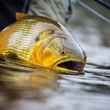




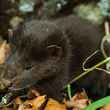
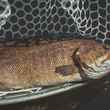








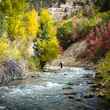
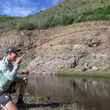




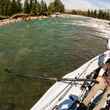

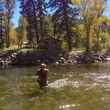
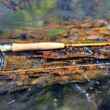
Comments
Andrew replied on Permalink
This is where a guide or fishing buddy comes in handy. Particularly one that's slower moving than yourself...
Pages